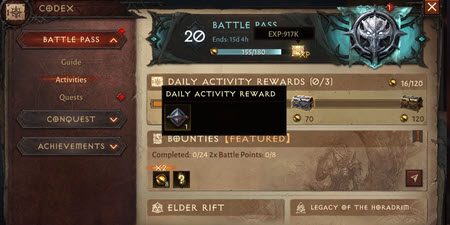Diablo Immortal is an action role-playing game (ARPG) developed by Blizzard Entertainment in collaboration with NetEase. Here's a detailed description:
Contents
Barbarian Class in Diablo Immortal
Crusader Class in Diablo Immortal
Demon Hunter Class in Diablo Immortal
Necromancer Class in Diablo Immortal
Wizard Class in Diablo Immortal
Diablo Immortal Gameplay Mechanics
Character Progression and Leveling
Clan and Social Features in Diablo Immortal
Diablo Immortal Strategy Guide
Endgame Content in Diablo Immortal
Daily and Weekly Activities in Diablo Immortal
Top 10 Tips & Tricks for Playing Diablo Immortal
About:
•Genre: Action RPG, Hack and Slash
•Platform: Mobile (iOS, Android) and PC
•Release Date: June 2, 2022
Diablo Immortal Gameplay:
•Combat: Diablo Immortal retains the series' signature fast-paced, click-based combat system. Players engage in real-time battles with hordes of enemies, using a variety of attacks, spells, and abilities based on their chosen class.
•Classes: At launch, there were six classes available - Barbarian, Crusader, Demon Hunter, Monk, Necromancer, and Wizard. Each class has unique skills and playstyles.
•Progression: The game features a deep progression system where players can level up, gather gear, enhance skills, and improve their characters. There's a main storyline alongside numerous side quests and repeatable content like dungeons and world events.
Diablo Immortal Story:
•Setting: The game is set between the events of "Diablo II" and "Diablo III." Players explore the world of Sanctuary, battling against the forces of Hell.
•Plot: The narrative involves chasing after the captured Worldstone shard pieces, which are pivotal in the eternal conflict between Heaven and Hell. Characters from previous Diablo games make appearances, adding depth to the lore.
Diablo Immortal Features:
•Co-op and PvP: Players can team up for cooperative play in dungeons or participate in PvP combat in the Battlegrounds or Cycle of Strife, which involves capturing and holding zones in the game's open world.
•Microtransactions: The game has received attention for its monetization model, featuring optional purchases for cosmetic items, boosts, and in some cases, gameplay advantages like gear or materials that can speed up progression. However, the core game can be played without spending money.
•Graphics and Sound: For a mobile game, Diablo Immortal boasts impressive graphics with detailed environments, character models, and effects. The audio, including the iconic score by Blizzard, enhances the dark, immersive atmosphere of the Diablo universe.
Diablo Immortal Community and Reception:
•Community: There's a dedicated community around Diablo Immortal, with forums, social media, and in-game chat fostering interaction among players.
•Reception: The game has been praised for its visuals and gameplay but has also faced criticism for its monetization practices, especially concerning the balance between free-to-play and pay-to-win elements.
Diablo Immortal Updates and Expansion:
Blizzard has been actively supporting Diablo Immortal with regular updates, including new content like zones, dungeons, events, and additional classes or features to keep the game fresh.
Barbarian Class in Diablo Immortal
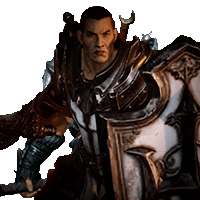
Barbarian Class in Diablo Immortal, Image via: wiki.fextralife.com
The Barbarian in "Diablo Immortal" is the embodiment of raw strength and fury. This class is built for players who relish direct, visceral combat. Barbarians are known for their ability to absorb punishing blows while unleashing devastating attacks. They are the frontline warriors of Sanctuary, capable of controlling the battlefield with their sheer physical prowess.
Strengths:
•High Damage Output: Barbarians are masters of melee combat, with skills designed to cleave through enemies or deal massive single-target damage.
•Durability: With a naturally high health pool and skills that enhance their survivability, they can take a lot of punishment before going down.
•Crowd Control: Abilities like Whirlwind allow them to manage groups of enemies, keeping them in check or pulling them together for AoE damage.
•Mobility: Despite their heavy armor, skills like Leap offer surprising mobility, allowing Barbarians to quickly engage or disengage from combat.
Weaknesses:
•Ranged Vulnerability: Against enemies that keep their distance, Barbarians might struggle unless they can close the gap or use ranged skills efficiently.
•Resource Management: Their primary resource, Fury, is generated in combat, meaning they must be in the thick of the fight to maintain their most powerful abilities.
•Single-Target Focus: While they have some area damage capabilities, Barbarians are often more effective against one or a few targets unless using specific AoE skills.
Notable Skills:
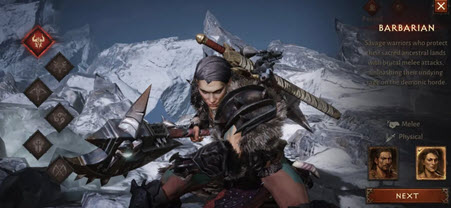
•Whirlwind: This iconic ability allows the Barbarian to spin continuously, damaging all nearby enemies, perfect for crowd control and area damage.
•Leap: Enables the Barbarian to jump into the air and crash down on foes, dealing damage and potentially stunning them. It's great for initiating combat or repositioning.
•Hammer of the Ancients: A powerful slam that can hit multiple enemies, offering high burst damage when used correctly.
•Wrath of the Berserker: Transforms the Barbarian into a berserk state, increasing damage, attack speed, and granting various buffs, making them nearly unstoppable for a short time.
•Ground Stomp: Stuns all nearby enemies, providing a moment of control or an opportunity for the Barbarian to heal or reposition.
•Playstyle: Barbarians thrive in melee combat, where they can leverage their strength and resilience. The gameplay involves rushing into battle, using crowd control to manage enemy positions, and unleashing powerful attacks. Strategic use of mobility skills to dictate the flow of battle is key, as is managing the Fury resource to ensure you're never out of steam when it counts.
Customization:
Barbarians can be tailored in various ways:
•Tank Build: Focusing on survivability with gear and skills that boost health, armor, and damage mitigation.
•Damage Dealer: Emphasizing skills that maximize attack power, critical hit chance, or area damage for clearing groups or dealing with bosses.
•Hybrid: Balancing between offense and defense, using skills like Wrath of the Berserker to amplify both aspects during key moments of combat.
Suitable For:
Players who love the adrenaline of melee combat, want to feel like a juggernaut on the battlefield, or enjoy the tactical aspect of positioning and controlling enemy movements. Barbarians offer a straightforward yet rewarding playstyle for those who appreciate the simplicity of hitting hard and often.
Crusader Class in Diablo Immortal

Crusader Class in Diablo Immortal, Image via: wiki.fextralife.com
The Crusader in "Diablo Immortal" is a class that blends the roles of protector and punisher. As a holy warrior, they serve as the frontline defense, using their faith and martial prowess to shield allies and smite foes. Crusaders are known for their heavy armor, divine magic, and a balanced approach between offense and defense.
Strengths:
•Versatile Combat: Crusaders can engage in both melee and ranged combat, using swords, maces, or holy spells to deal damage or control enemies.
•Strong Defensive Capabilities: They possess some of the best defensive tools in the game, including shields for blocking and spells for self-healing or damage reduction.
•Crowd Control: Skills like Shield Glare can blind or stun enemies, providing an edge in group fights.
•Sustainability: With abilities to regain health through combat or divine intervention, Crusaders are durable in prolonged fights.
Weaknesses:
•Mobility: Although they have some mobility skills, Crusaders are generally less agile than classes like the Demon Hunter or Monk. Positioning is crucial for their effectiveness.
•Resource Management: Like many classes, managing their primary resource (Spirit for Crusaders) is key to maintaining both offensive and defensive capabilities.
•Complexity: While not the most complex class, mastering the balance between attack, defense, and support requires strategic thinking, especially in group play.
Notable Skills:
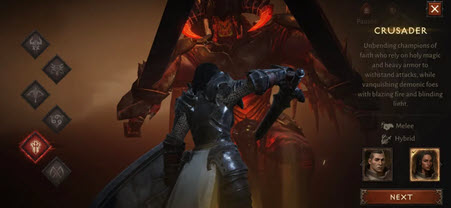
•Shield Glare: A blinding light from the Crusader's shield that can stun or disorient multiple enemies, perfect for crowd control.
•Falling Sword: The Crusader leaps into the air, then slams down, dealing significant area damage where they land. It also provides a brief invulnerability during the leap, useful for repositioning or escaping.
•Consecration: Creates a holy ground that damages enemies while healing or boosting allies, showcasing the Crusader's supportive capabilities.
•Condemn: Summons divine energy around the Crusader that pulls enemies in and deals damage, controlling the battlefield and setting up for further attacks.
•Iron Skin: A defensive skill that absorbs a significant amount of damage, making the Crusader temporarily impervious or highly resistant to harm.
•Playstyle: Crusaders are designed for players who enjoy being the anchor of the team, soaking up damage while also contributing to the fight. They can switch between a defensive stance, protecting allies, and an offensive one, smiting enemies with divine wrath. Their playstyle involves careful positioning, timing of defensive and offensive skills, and managing resources to maintain a balance in combat.
Customization:
The Crusader's equipment and skill choices allow for various builds:
•Tank Build: Focusing on survival and protection skills, using gear that boosts health and defense.
•Damage Dealer: Emphasizing skills that maximize damage output, possibly with gear that enhances attack power or critical hits.
•Support Crusader: Utilizing abilities like Consecration to support allies in group play, with gear that might enhance healing or buff effects.
Suitable For:
Players who relish the role of a frontline warrior, enjoy balancing between attack and defense, or those who like to support their team while still being a formidable combatant. The Crusader is particularly appealing for those who appreciate a class with a rich lore of righteousness and battle-hardened tactics.
Demon Hunter Class in Diablo Immortal
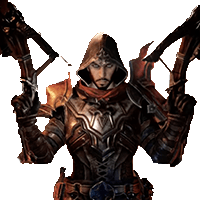
Demon Hunter Class in Diablo Immortal, Image via: wiki.fextralife.com
The Demon Hunter in "Diablo Immortal" is the quintessential ranged combatant, focusing on precision, mobility, and setting deadly traps. They are the masters of ambush, using bows, crossbows, and various gadgets to dismantle their enemies from a distance. Demon Hunters are agile, quick to dodge, and adept at controlling the battlefield with their array of skills.
Strengths:
•High Single-Target Damage: With skills tailored for precision strikes, Demon Hunters excel at dealing significant damage to single targets, making them ideal for boss encounters.
•Mobility: Abilities like Vault allow for quick repositioning or evasion, making Demon Hunters hard to pin down in combat.
•Area Control: They can set traps like Caltrops or Sentry to control enemy movement, manage crowds, or create zones of danger.
•Resource Management: Demon Hunters use Hatred for most attacks (generated through combat) and Discipline for more specialized abilities (which regenerates over time), offering strategic depth.
Weaknesses:
•Vulnerability: With less health and armor compared to melee classes, Demon Hunters must rely on their agility and positioning to avoid taking hits.
•Dependence on Resources: Effective use of their abilities requires careful management of Hatred and Discipline to maintain a flow of combat without running dry.
•Close-quarters Combat: While they have some melee options, Demon Hunters are at a disadvantage if enemies get too close, necessitating constant movement.
Notable Skills:
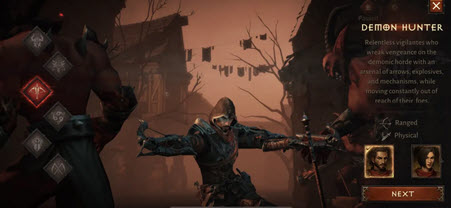
•Strafe: Fires arrows in all directions, dealing damage to all nearby enemies, perfect for clearing groups while maintaining distance.
•Vault: A dash that not only allows for quick escapes but can also be upgraded to deal damage or set traps upon landing.
•Sentry: Summons a turret that automatically attacks enemies, adding to the Demon Hunter's control over the battlefield.
•Multishot: Unleashes a volley of arrows in a wide arc, excellent for dealing with multiple enemies at once.
•Smoke Screen: Creates a cloud of smoke for invisibility, giving the Demon Hunter a chance to reposition or escape.
•Knife Trap: A trap that deals massive damage and knocks back enemies when triggered, adding to their area denial capabilities.
•Playstyle: The Demon Hunter’s gameplay is all about maintaining distance, controlling the field, and executing precise attacks. Players need to be adept at kiting enemies, setting up ambushes with traps, and knowing when to engage or disengage. It's a high-risk, high-reward class where positioning and timing are everything.
Customization:
•Assassin Build: Focused on maximizing single-target damage with skills like Impale or Vengeance for boss fights.
•Area Control Build: Emphasizing traps and area damage skills like Multishot or Chakram to handle groups.
•Survival Build: Using skills that enhance mobility, evasion, and defensive capabilities like Smoke Screen or Evasive Fire.
Suitable For:
Players who enjoy the thrill of the hunt, strategic placement of traps, and the challenge of managing resources while weaving in and out of combat. Demon Hunters appeal to those who prefer a more calculated approach to combat, requiring quick reflexes and tactical thinking. They are perfect for players who like to dictate the pace and location of battles rather than being dictated to by the enemy.
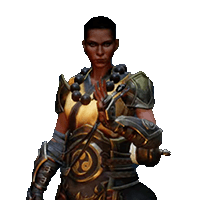
Monk Class in Diablo Immortal, Image via: wiki.fextralife.com
The Monk in "Diablo Immortal" is a class that blends the speed and precision of martial arts with mystical spirit energy. Monks are agile fighters who excel at both dealing damage and healing, offering a unique playstyle that requires balance and control. They are masters of close combat, using their body as a weapon while harnessing spiritual energies for support and damage.
Strengths:
•Speed and Mobility: Monks are among the most agile classes, with skills that allow for quick movement across the battlefield, dodging, and engaging or disengaging from combat as needed.
•Versatile Combat: They can switch between dealing high melee damage, controlling enemies with crowd-control abilities, and providing healing or buffs to themselves or allies.
•Self-Sustainability: With abilities to heal themselves, Monks have excellent longevity in battle, reducing reliance on external healing.
•Spirit Management: Monks use Spirit as a resource, which is generated through combat, allowing for a dynamic flow of offensive and defensive abilities.
Weaknesses:
•Resource Intensive: Effective use of abilities requires careful management of Spirit, especially in prolonged fights where regeneration might not keep up with expenditure.
•Close-Range Focus: While they have some ranged options, Monks are primarily melee fighters, which can be a disadvantage against enemies that keep their distance or in situations where kiting is necessary.
•Complexity: The balance of offense, defense, and support can be complex for beginners, requiring practice to master the flow of combat.
Notable Skills:
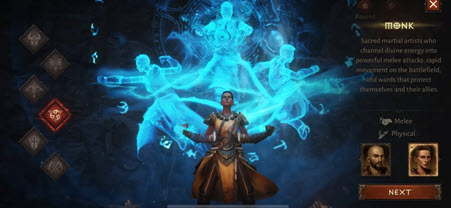
•Seven-Sided Strike: The Monk vanishes and strikes seven times at random enemies, dealing significant damage. This skill is great for both single-target damage and crowd control.
•Cyclone Strike: Pulls enemies into a vortex around the Monk, dealing damage and allowing for follow-up area attacks or crowd control.
•Mystic Ally: Summons an ally that fights alongside you, providing additional damage or defensive support based on the upgrade path chosen.
•Exploding Palm: Marks an enemy for a delayed explosion, causing massive damage if the enemy is defeated while marked, excellent for chain reactions in groups.
•Inner Sanctuary: Creates a zone of peace where enemies can't attack, giving the Monk time to heal, regroup, or prepare for the next assault.
•Breath of Heaven: A burst of healing energy that restores health to the Monk and nearby allies, showcasing their supportive capabilities.
Playstyle:
Monks are all about rhythm in combat, weaving between aggressive attacks and defensive maneuvers. Their gameplay involves mastering the timing of when to strike, when to heal, and when to use crowd control to maintain control over the battlefield. Positioning and understanding enemy patterns are key to getting the most out of the Monk’s capabilities.
Customization:
The Monk's equipment and skill choices allow for various builds:
•Damage Focused: Emphasizing skills like Wave of Light or Lashing Tail Kick for high burst or sustained damage output.
•Support Build: Utilizing abilities like Breath of Heaven or Mantra of Healing to bolster team survivability.
•Control Build: Focusing on skills like Cyclone Strike or Inner Sanctuary to dominate the battlefield with crowd control.
Suitable For:
Players who enjoy a fast-paced, high-skill combat style, love the balance between offense and defense, or those who appreciate the monk's lore of enlightenment through battle. Monks are particularly appealing for those who like to manage resources actively and adapt their strategy on the fly based on the situation at hand.
Necromancer Class in Diablo Immortal
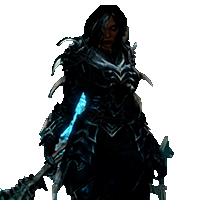
Necromancer Class in Diablo Immortal, Image via: wiki.fextralife.com
The Necromancer in "Diablo Immortal" is a dark mage who commands the forces of death. They wield dark magic to manipulate life and death, summon undead minions, and cast spells that can either bolster their own forces or weaken enemies. Necromancers are versatile, capable of dealing significant damage, controlling the battlefield, and providing a unique form of support through their summoned creatures.
Strengths:
•Summoning Abilities: Necromancers can summon skeletons, mages, or other undead creatures to fight for them, providing both offensive power and a frontline defense.
•AoE and DoT Spells: They excel in area-of-effect damage and damage over time, with spells like Bone Spear or Corpse Explosion, making them effective against groups.
•Resource Management: Using Essence, which is generated from corpses or through certain skills, Necromancers can maintain a steady flow of power for both summoning and casting.
•Control and Support: Beyond damage, they can use curses to debuff enemies or spells to support their minions, offering tactical advantages in combat.
Weaknesses:
•Minion Dependency: Their effectiveness can be tied to the health and presence of their minions, which can be vulnerable and need constant management.
•Complex Gameplay: Balancing between casting spells, managing Essence, and controlling minions adds layers of complexity, which might be challenging for new players.
•Mobility: While they have some mobility spells, Necromancers tend to be less agile, making positioning crucial for success.
Notable Skills:
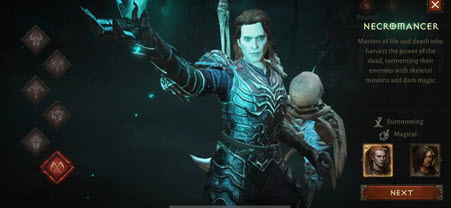
•Skeletal Mage: Summons mages that cast spells, adding ranged damage or utility to the Necromancer's arsenal.
•Skeletal Warriors: Calls forth warriors to tank hits and deal melee damage, serving as both a shield and an offensive force.
•Bone Spear: Fires a projectile that can pierce through multiple enemies, ideal for single-target or concentrated group damage.
•Corpse Explosion: Causes any nearby corpse to explode, dealing massive area damage. This skill is central to the Necromancer's AoE strategy.
•Command Skeletons: Direct control or enhancement of your skeletal minions, allowing for strategic deployment on the battlefield.
•Grim Scythe: A melee attack that can generate Essence and potentially curse enemies, setting up for more potent spell effects.
•Decrepify: A curse that slows and weakens enemies, providing control over the battlefield or boosting your damage against cursed foes.
Playstyle:
Necromancers in "Diablo Immortal" are about orchestrating death from multiple fronts. Players need to manage their Essence, decide when to summon, when to cast damaging spells, and how to use the battlefield's corpses for maximum effect. The class offers a unique blend of active combat with strategic oversight, as you're not only fighting but commanding an undead army.
Customization:
The Necromancers's equipment and skill choices allow for various builds:
•Summoner Build: Focuses heavily on minion quantity and quality, using skills to summon more or stronger undead.
•Spellcaster Build: Emphasizes direct damage and control spells, using minions as a secondary aspect or for specific roles.
•Hybrid: Balancing between summoning, direct damage, and corpse manipulation for a versatile approach to combat.
Suitable For:
Those who enjoy complex strategic gameplay, love the theme of death and necromancy, or players who want to experience the game from the perspective of a commander leading an undead horde. Necromancers appeal to those who like to set up scenarios where your minions do the bulk of the fighting while you cast devastating spells from the shadows.
Wizard Class in Diablo Immortal
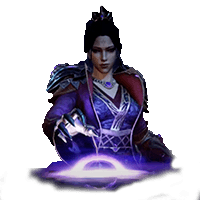
Wizard Class in Diablo Immortal, Image via: wiki.fextralife.com
The Wizard in "Diablo Immortal" is the epitome of magical might, harnessing the arcane to unleash devastating spells. Known for their intelligence and mastery over the elements, Wizards are the quintessential glass cannons, capable of obliterating enemies from afar with their spells. They control the battlefield with a mix of crowd control, area denial, and high damage output, often from a safe distance.
Strengths:
•High Spell Damage: Wizards can deal enormous amounts of damage with their spells, particularly effective against single targets or groups with area-of-effect (AoE) spells.
•Crowd Control: With abilities like Frost Nova or Slow Time, they can lock down enemies, providing control over the battlefield.
•Mobility: Spells like Teleport give Wizards the ability to quickly reposition, escape, or chase down enemies, enhancing their survivability.
•Versatility: Their wide range of spells allows for various combat strategies, from direct damage to defensive or supportive roles.
Weaknesses:
•Low Durability: Wizards have lower health pools and armor, making them fragile if caught by melee enemies or if their crowd control fails.
•Resource Management: Arcane Power, their primary resource, must be managed carefully to avoid running dry during critical moments.
•Positioning: Their effectiveness heavily relies on maintaining distance from enemies, requiring constant awareness and positioning.
Notable Skills:
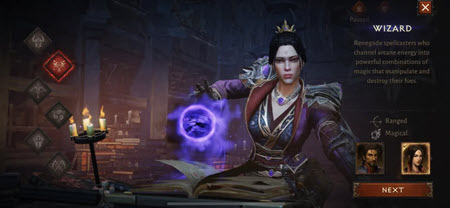
•Meteor: Summons a massive fireball from the sky, dealing significant area damage where it lands. It's a signature high-damage spell for crowd clearing.
•Disintegrate: Channels a beam of energy that deals continuous damage to a single target or sweeps through multiple enemies, excellent for both single-target and AoE damage.
•Teleport: Allows for quick movement, either to escape danger or to close in for a follow-up attack, crucial for a class with low survivability.
•Frost Nova: Freezes all nearby enemies, providing a moment of invulnerability or time to reposition or cast another spell.
•Arcane Wind: A defensive spell that knocks back enemies and provides a temporary shield, offering a lifeline when surrounded.
•Slow Time: Creates a bubble that slows enemies within it, giving the Wizard time to deal damage safely or escape.
•Magic Missile: A basic but effective spell for consistent damage or to generate Arcane Power through specific upgrades.
Playstyle:
Wizards are all about casting from a distance, controlling the flow of battle, and ensuring they never let enemies get too close. Strategy involves managing resources (Arcane Power) to time spells for maximum impact, using crowd control to keep enemies at bay, and leveraging mobility to maintain the perfect range for spellcasting.
Customization:
The Wizards's equipment and skill choices allow for various builds:
•Damage Focus: Prioritizing spells like Meteor or Disintegrate for raw damage output, with gear enhancing spell power and critical hit chances.
•Control Wizard: Emphasizing skills that manipulate enemy movements or reduce their capabilities, like Frost Nova or Slow Time.
•Survivability Build: Combining spells with defensive aspects or using items that increase health or shield capabilities to mitigate the class's inherent fragility.
Suitable For:
Players who enjoy the feeling of power that comes with casting mighty spells, love strategic gameplay around positioning and resource management, or those who appreciate the lore of mastering arcane arts. Wizards are perfect for those who like to dominate the battlefield from a distance, weaving magic to their advantage in every encounter.
This guide should help you make an informed decision on which class to start with in Diablo Immortal, tailored to both your play style and ease of entry into the game's mechanics.
Diablo Immortal Gameplay Mechanics
Customization for Precision:
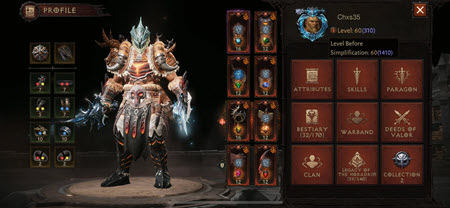
•Button Layout: Go into settings to adjust the size, opacity, and placement of control elements. Tailor them to your hand size or play style for better control in intense situations.
•Skill Activation: For precision, you can tap on an enemy to target them directly with a skill, especially useful for skills that don't auto-target well or for crowd control effects.
Advanced Movement:
•Double Tap to Sprint: A double tap on the movement joystick can initiate a sprint, letting you cover ground quickly or escape danger.
•Tap to Teleport: For classes with teleport abilities, a quick tap can engage this for immediate repositioning.
Interface Utilization:
•Quick Menu Access: Learn to swipe or tap specific areas for quick access to menus like inventory or skills without leaving combat, crucial for on-the-fly adjustments.
•Minimap Tactics: Use the minimap not only for navigation but to anticipate enemy movements or find hidden objectives.
Combat Basics: Advanced Tactics 
•Auto vs. Manual Attack - Mastery:
•Manual Targeting: For classes with ranged capabilities, manually aiming can increase efficiency, hitting critical areas on bosses or focusing on priority targets in groups.
•Skill Chain: Learn to chain auto attacks with skills for better damage output. Some skills are enhanced or have different effects when used after specific attacks or other skills.
Skill Usage - Optimization: 
•Skill Rotation: Develop a rotation or sequence of skills for different scenarios. This includes knowing when to use high-cooldown abilities for maximum impact.
•Skill Synergy: Some skills work better together; understand synergies like using crowd control before an AoE attack or combining buffs/debuffs.
Environmental Awareness:
•Terrain Advantage: Use the environment for combat advantage, like pulling enemies to narrow passages or using obstacles for cover.
Resource Management: Advanced Techniques 
•Potion Timing: Save potions for moments where you can't avoid damage or during boss fights. Understand when you'll naturally heal versus needing a potion.
•Healing Skills: If your class has healing abilities or passives, integrate them into your combat rhythm to maintain health without over-relying on potions.
Energy/Resource Manipulation: 
•Resource Generation: Know which skills or passives generate resources. Some classes have specific mechanics for this, like converting damage taken into resources.
•Resource Conservation: Use lower-cost abilities or passives that help conserve or regenerate your class's resource during combat lulls.
Cooldown Mastery:
•Cooldown Reduction: Invest in gear or skills that reduce cooldowns, allowing more frequent use of powerful abilities.
•Planned Downtime: Use cooldowns of less critical skills to cover the downtime of your main abilities, ensuring you always have something effective to do.
Ultimate Ability Management:
•Ultimate Timing: Save your ultimate for the right moment, like when multiple enemies are grouped or when a boss is at a critical phase.
•Ultimate Synergy: Combine your ultimate with other skills or team abilities for amplified effects.
General Tips: 
•Buff/Debuff Stacking: Learn the timing of buffs you can apply to yourself or debuffs to enemies for strategic advantage.
•Crowd Control Mastery: Use CC to manage threat or buy time for cooldowns, especially in tougher content like raids or dungeons.
•Adaptability: Be ready to adjust your strategy based on the enemy's behavior, your team's composition, or the specific demands of the encounter.
Mastering these advanced mechanics will significantly elevate your gameplay in "Diablo Immortal", allowing you to handle more complex combat scenarios, optimize your build, and contribute more effectively in group play.
Character Progression and Leveling
Efficient Leveling Tips: 
•Zone-Specific Quests: Prioritize main story quests as they offer substantial XP. Each zone has its main questline that provides a clear path for leveling.
•Bounties: Regularly check the bounty board for tasks. They offer good XP and are repeatable, providing a consistent source of progression.
•Events: Participate in world events. These are dynamic and can be found throughout the map, offering XP for all participants.
•Dungeons: Frequent dungeon runs, especially the highest difficulty you can handle, give a lot of XP. Try to do these with a group for faster clear times.
•Rift Runs: Once unlocked, rifts provide excellent XP, particularly Elder Rifts which also drop legendary gems.
•Kill Streak: Maintain a kill streak to increase XP gains. Avoid dying as it resets your streak.
•Rest XP: Log in daily to accumulate Rest XP, which boosts your XP gain for a period after logging back in.
Unlocking and Upgrading Skills:
•Skill Points: You earn skill points by leveling up. These can be used to unlock or upgrade skills.
•Skill Tree: Each class has its unique skill tree. Invest in skills that synergize well with your playstyle or the current gear you're using.
•Skill Upgrades: Upgrades often change how a skill functions or increases its potency. Experiment with different upgrades in the training area to see effects.
•Ultimate Abilities: These are powerful skills that charge over time or through combat actions. Choose wisely based on your combat role.
•Skill Rotation: Develop a rotation of skills for both single-target and AOE scenarios to maximize damage output and efficiency.
Understanding Item Rarity and Stats: 
•Common (White): Basic gear with minimal stats.
•Magic (Blue): Better than common, with one or two affixes.
•Rare (Yellow): Multiple affixes, significantly improving stats.
•Legendary (Orange): Unique effects or bonuses, often game-changing for builds.
•Set Items: Part of sets that give bonuses when multiple pieces are worn.
•Primary Stats: These are class-specific like Strength for Barbarians, affecting damage and life.
•Secondary Stats: Include attributes like Critical Hit Chance, Attack Speed, etc., which enhance gameplay mechanics.
Inventory Management: 
•Salvage: Break down gear you don't need for crafting materials. Legendary items should be salvaged for set recipes or legendary essence.
•Sell: Vendor items that aren't worth salvaging for gold.
•Stash: Use your stash for gear you might need later or for alternate builds.
•Gear Sets: Focus on completing sets for significant bonuses, but don't hesitate to use a non-set legendary if it's a substantial upgrade.
•Gear Upgrades:
•Reforging: Use the blacksmith to reroll stats on your gear for better attributes.
•Enchanting: Change one attribute on an item, but this can be costly, so use it wisely.
Remember, the effectiveness of your Inventory Management strategy can also depend on your group composition if you're playing with others. Adapt your build to complement your allies or to fill gaps in your team's capabilities. Keep an eye out for buffs or nerfs in updates, as they can change the meta. Good luck, and may your journey through Sanctuary be filled with loot and glory!
Here's an in-depth strategy guide for tackling dungeons in Diablo Immortal, covering different types of dungeons, preparation, and boss fight tactics:
Types of Dungeons:
•Normal Dungeons:
▪Purpose: Primarily for leveling and farming gear.
▪Variety: Each zone has its own dungeon with unique layouts and enemies but similar mechanics.
▪Reward: XP, gold, and various rarities of gear.
•Elder Rifts:
▪Purpose: End-game content for high-level players, focusing on acquiring legendary gems.
▪Mechanics: Players fight through waves of enemies with increasing difficulty, culminating in a boss fight.
▪Reward: Upon completion, you get to choose a legendary gem from a selection, and you can use a Crest to potentially get better gems.
•Challenge Rifts:
▪Purpose: Test your build against a predefined character setup.
▪Mechanics: You play through a dungeon with a character loadout provided by Blizzard, aiming for the highest score based on speed and efficiency.
▪Reward: Completing these weekly gives you items like keys for more Elder Rifts, gold, and sometimes unique cosmetic items.
Preparation for Dungeons: 
•What to Bring:
▪Consumables: Health potions, elixirs for various buffs (e.g., increased damage or XP), and scrolls for emergency situations.
▪Appropriate Gear: Make sure your gear is up to par with the dungeon's difficulty. Check for resistances to common damage types in the dungeon.
▪Crests: For Elder Rifts, having crests can significantly improve your rewards.
▪Team Composition: If possible, coordinate with a group where each player fills a necessary role (tank, DPS, support).
•What to Expect:
▪Enemy Density: Dungeons are designed with high enemy density to keep the action intense.
▪Traps and Hazards: Be aware of environmental dangers like traps or poison clouds.
▪Boss Phases: Bosses often have multiple phases with increased difficulty or new mechanics each time.
Boss Fights: 
•General Tactics:
▪Learn Mechanics: Each boss has unique mechanics. Observing or dying once can teach you much about what to avoid or exploit.
▪Positioning: Avoid standing in harmful areas or attacks. Use the arena to your advantage, like dodging behind pillars or obstacles.
▪Burst Damage: Save your ultimate and cooldowns for when the boss enters a vulnerable phase or is about to transition.
▪Debuffs and Buffs: Use debuffs on the boss to reduce incoming damage or increase outgoing damage. Apply buffs to yourself or allies for critical moments.
•Specific Boss Tactics: General Boss (Example from Normal Dungeons):
▪Name: Skeleton King
▪Tactics: Watch out for his charge attack, dodge it by moving perpendicular to his path. During his shield phase, use area of effect (AoE) attacks to break his shield faster.
•Elder Rift Bosses:
▪Name: Vidian, the Lord of Envy
▪Tactics: He phases through the floor, emerging to attack. Stay mobile to avoid his ground slam and subsequent poison pools. When he summons adds, focus on clearing them quickly before they heal him.
•Challenge Rift Bosses:
▪Name: Varies, but tactics involve using the pre-set skills to their maximum potential, often requiring precise timing or area control.
Basic Dungeon Tips: 
•Adaptation: Be ready to change your strategy if what you're doing isn't working.
•Communication: If in a group, communicate boss mechanics and coordinate attacks or defenses.
•Practice: Especially for Elder Rifts, running them multiple times can help you perfect your strategy.
Remember: the key to success in dungeons is not just about having the best gear but understanding and adapting to the game's mechanics. Good luck, and may your dungeons be filled with epic loot! |
Here's a specialized guide for PvP combat in Diablo Immortal, focusing on battlegrounds, strategies, and gear:
Overview of PvP Modes:
•Battlegrounds:
▪Mode: A team-based PvP arena where two teams of eight players each fight to capture three points on the map.
▪Objective: Control at least two out of the three points to win. Points are captured by standing in designated areas.
▪Duration: Matches last for about 6 minutes or until one team reaches the score threshold.
•Cycle of Strife:
▪Mode: An open-world PvP event where players from different immortal factions (Shadows and Immortals) battle for control over zones.
▪Objective: Capture and hold beacons to earn points for your faction.
•Duels:
▪Mode: One-on-one combat for settling scores or testing your build.
▪Objective: Defeat your opponent or outlast them within the time limit.
Strategies for Success: 
•Team Composition:
Balance: Aim for a mix of roles: Tank: To absorb damage and control capture points. DPS (Damage Per Second): To quickly take down enemies or clear points. Support: For healing and buffs, ensuring team longevity. Class Synergy: Certain classes work well together. For instance, pairing a Necromancer's crowd control with a Barbarian's front-line presence can be very effective.
•Positioning:
Capture Points: Position your tank at the capture points to contest or hold them. Support should stick close to provide heals or buffs. Flanking: Use agile classes like Demon Hunter or Monk to flank and disrupt the enemy's backline, focusing on their support or key DPS.
•Use of Terrain:
High Ground: If available, use elevated positions for ranged attacks and to avoid melee enemies. Choke Points: Funnel enemies through narrow passages where you can maximize AoE damage or crowd control.
•General Tactics:
Communication: Coordinate with your team for movements, when to push, or when to retreat. Focus Fire: Target one enemy at a time for quicker kills, reducing the enemy's numbers. Disruption: Use abilities that can disrupt the enemy's strategy, like stuns, slows, or knockbacks.
PvP Gear Choices:
•Legendary Gear:
Focus on PvP Stats: Look for items with attributes like "Reduces control impairment duration" or "Increases damage against players." Set Bonuses: Some sets like the "Grace of the Flagellant" for Crusaders can be very PvP-focused with crowd control reduction and damage boosts when below certain health thresholds.
•Jewelry & Gems:
Amulets and Rings: Seek those with PvP-specific affixes like "Reduces damage taken from players" or "Increases damage dealt to players."
Legendary Gems: Gems like Blessing of the Worthy (reduces damage taken from players) and Pain of Subjugation (increases damage against controlled enemies) are particularly useful.
•Attributes to Focus On:
Toughness: Health, armor, resistances for staying power in fights.
Offense: Critical hit chance, attack speed, and damage modifiers for efficient kills.
Utility: Cooldown reduction, resource cost reduction for more frequent use of abilities.
Gear Management:
•Reforge and Enchant: Regularly adjust your gear's stats to better fit PvP scenarios. For instance, more control impairment reduction might be better than pure damage in some situations.
•Inventory: Keep multiple gear sets if possible, one tailored for PvP and another for PvE.
Remember: PvP in Diablo Immortal is not just about raw power but how well you can outmaneuver and outthink opponents. Adapt your strategy based on who you're fighting against. Different classes and builds require different approaches. |
Clan and Social Features in Diablo Immortal
By actively engaging with the social features in Diablo Immortal, you not only enhance your gameplay experience but also open up avenues for rapid progression and access to exclusive content. Remember, the strength of your social network can often be as important as the strength of your character.
Here's a comprehensive guide to understanding and leveraging clan and social features in Diablo Immortal.
Benefits of Joining or Creating a Clan:
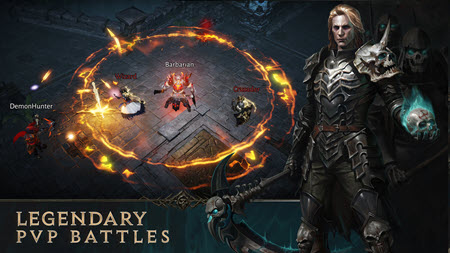
•Clan Buffs: Active membership in a clan provides passive buffs like increased experience from monsters, more gold from combat, or better magic find.
•Clan Quests: Participate in group activities to earn rewards that can be shared among members.
•Raids and Dungeons: Easier to organize and complete with clan members for better gear and experience.
•Clan Store: Access to exclusive items using clan currency (Aether).
•Social Support: New players can receive guidance, and everyone can share strategies or resources.
How to Join a Clan: 
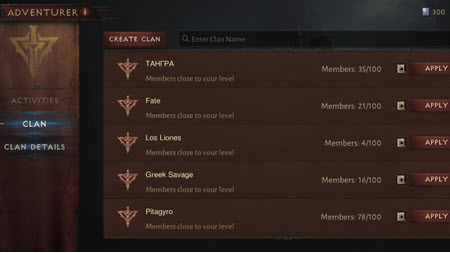
1.Search for a Clan: Navigate to the clan tab, where you can search or browse clans based on language, level, or focus (PvP, PvE, etc.).
2.Apply: Send an application to join. Some clans might have requirements or interviews.
3.Approval: Wait for approval from a clan officer or leader.
Creating a Clan: 
1.Level Requirement: You need to be at least level 30 to create a clan.
2.Name and Tag: Choose a unique name and tag for your clan.
3.Invite Members: Start by inviting friends or players you've met in-game.
4.Set Goals: Define what your clan will focus on (e.g., casual play, hardcore PvP) to attract like-minded players.
Clan Wars Strategy: 
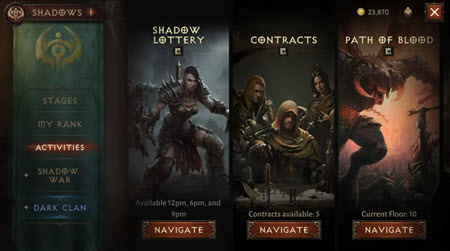
•Team Composition: Ensure you have a balanced team. Each member's role (tank, DPS, support) should complement each other.
•Communication: Use in-game chat or external platforms to strategize. Knowing your opponent's strengths and weaknesses can be key.
•Objective Focus: Depending on the war's structure, focus on objectives like capturing points or defeating key opponents.
•Preparation: Gear up with the best PvP gear, optimize your skills for PvP encounters, and stock up on consumables.
Clan Wars Benefits:
•Clan Aether: Winning wars rewards Aether, which can be used in the Clan Store for unique items or buffs.
•Reputation: Successful clans gain reputation, attracting more skilled players.
•Progression: Clan Wars can offer unique rewards or achievements, contributing to personal and clan advancement.
Social Interaction for Progression & Leveraging Friends:
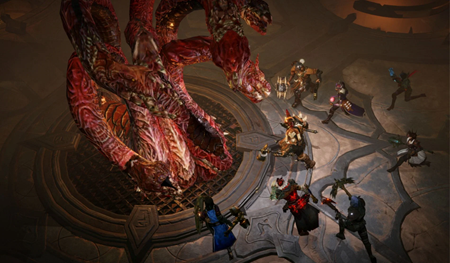
•Party Play: Group up for dungeons, rifts, or world events. XP and loot are often shared or increased in groups.
•Trading: While direct trading isn't traditional in Diablo, you can help each other by dropping items or through clan bank systems if implemented.
•Item Sharing: Sometimes, you might find gear better suited for a friend. Sharing can help strengthen the group's overall power.
Social Strategies: 
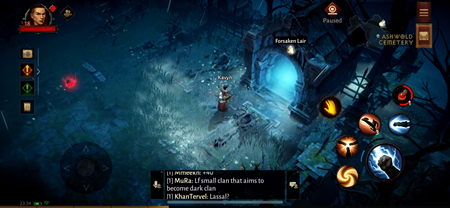
•Friendship Challenges:
Engage in daily challenges with friends for bonuses.
Mentorship: New players can benefit from veterans' knowledge, speeding up their learning curve. Raiding Together: Organize raids with friends for better success rates and more enjoyable gameplay.
Expanding Your Network: 
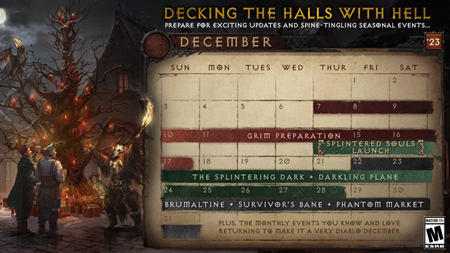
•Join Public Events:
Participate in world events or public raids to meet potential friends or clanmates. Social Platforms: Use Discord, Reddit, or the game's forums to connect with the community, find clans, or get involved in larger social groups.
Tips for Social Play: 
•Be Active: Regular participation in clan activities or helping out friends can lead to better integration and mutual benefits.
•Respect and Communication: Good social interaction is built on respect. Communicate clearly and positively, even in the face of losses or disagreements.
Resource Management in Diablo Immortal
Here's a detailed strategy guide for managing resources in Diablo Immortal, focusing on gold, gems, and Legendary Crests:
Gold: Efficient Ways to Earn Gold: 
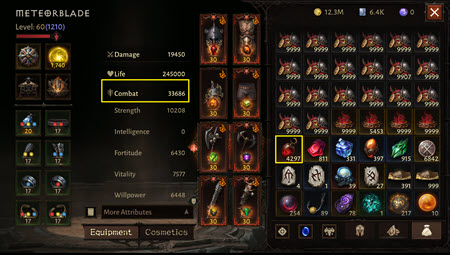
•Bounties: Daily bounties are a steady source of gold. Completing all bounties in a zone will net you a significant amount.
•Dungeons: Regularly running normal dungeons, especially on higher difficulties, can yield good gold drops from mobs and bosses.
•Events: World events often reward gold. They're repeatable and can be quite lucrative if you're efficient.
•Selling Gear: Sell unwanted gear to vendors, especially if it's not worth salvaging for materials.
•Elder Rifts: Even without crests, Elder Rifts give gold, but this is increased with crests.
Efficient Ways to Spend Gold: 
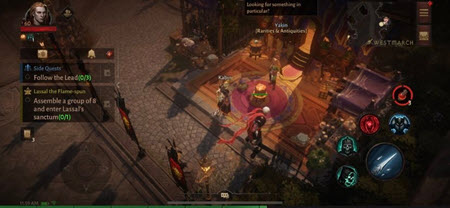
•Gear Upgrades: Reforging and enchanting gear at the blacksmith can significantly improve your stats but can be gold-intensive.
•Repairs: Keep your gear in good condition, especially after PvP or intense dungeon runs.
•Mounts and Cosmetics: While not essential for gameplay, these can be quality-of-life improvements or for personal satisfaction.
•Crafting: Occasionally, you might want to craft specific items or gems, which requires gold.
•Faction Bonuses: Investing in faction reputation can yield powerful buffs or items.
Tips for Gold Management: 
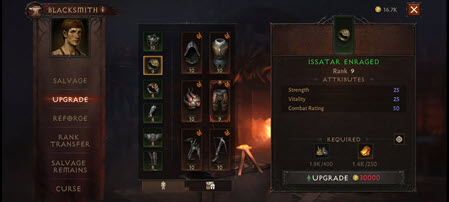
•Prioritize: Spend on upgrades that will improve your gameplay the most, like key pieces of gear or enchantments.
•Save for Events: Sometimes, Blizzard introduces events where spending gold can yield higher returns or unique items.
Gems and Gem Types:
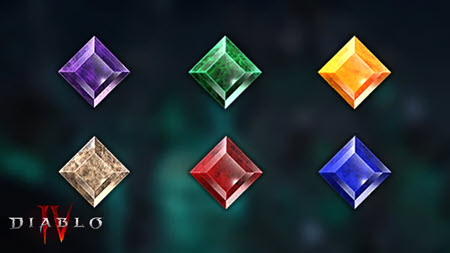
•Regular Gems: These come in various colors (e.g., Ruby for damage, Sapphire for defense).
•Uses: Socketed into gear to boost stats relevant to the gem's color and type (e.g., damage, life, resistance).
•Legendary Gems: These have unique effects beyond simple stat boosts.
•Uses: Only socketable into specific gear slots, they can dramatically alter gameplay with effects like damage against controlled targets or increased healing.
Farming and Crafting Gems:
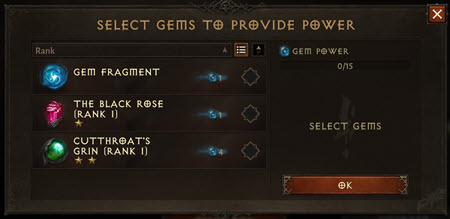
•Farming:
Adventuring: Gems drop from enemies, especially in higher difficulty areas or from elites. Rifts: Both regular and Elder Rifts can drop gems, with Elder Rifts potentially dropping Legendary Gems.
•Crafting:
Jeweler: You can craft regular gems at the jeweler, combining lower-tier gems into higher-tier ones. Upgrade Legendary Gems: At higher levels, you can use materials and gold to upgrade Legendary Gems, enhancing their effects.
Tips for Gem Management: 
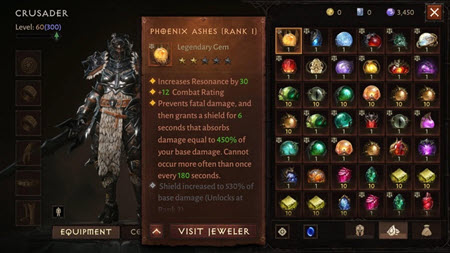
•Match Gems to Gear: Use gems that complement the gear's inherent stats or your build's needs.
•Legendary Gem Focus: Prioritize upgrading Legendary Gems that fit your playstyle or are crucial for your build.
Endgame Content in Diablo Immortal
Here's a detailed guide to navigating endgame content in Diablo Immortal, focusing on Helliquary Raids, Shadow War, and the use of Paragon Points. By mastering these aspects of Diablo Immortal's endgame, you can significantly enhance your character's capabilities, leading to better performance in both PvE and PvP scenarios. Remember, endgame is about refinement - both of your gear and your strategy.
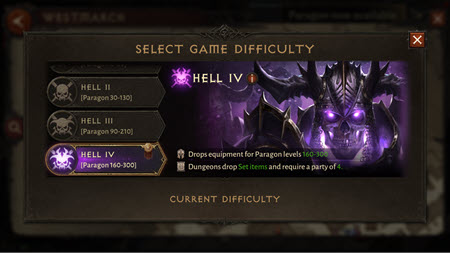
Preparation for Helliquary Raids: 
•Gear Up: Ensure your gear is at least T5 or higher, ideally with set bonuses and legendary items tailored to your build.
•Legendary Gems: Upgrade your gems to fit your strategy, especially focusing on those that help against bosses.
•Consumables: Stock up on potions, elixirs for damage or resistance, and scrolls for emergencies.
•Team Composition: Coordinate with a balanced team, including healers, tanks, and high DPS.
Strategies for Bosses: 
•Pierce the Veil (Helliquary Boss - Yorin):
•Mechanics: Yorin alternates between melee and ranged attacks, with phases where he summons adds.
•Strategy: Phase 1: Focus on dodging his frontal cone attack and the ground-targeted shadows. Add Phase: Quickly clear the adds to prevent healing or additional damage to the boss. Phase 2: Watch for his shadow clone; focus on the real Yorin while avoiding the clone's attacks.
General Tips: 
•Positioning: Use the arena to your advantage, staying spread out to avoid AoE attacks.
•Burst Damage: Coordinate your ultimates for boss phases where he's particularly vulnerable or to clear adds quickly.
•Communication: Call out boss mechanics or when to focus on adds.
•Rewards and Benefits: Helliquary Trophies: Used to summon tougher versions of bosses for better rewards. Gear and Gems: Potential for high-end drops, crucial for further progression.
Tips for Dominating Shadow War: 
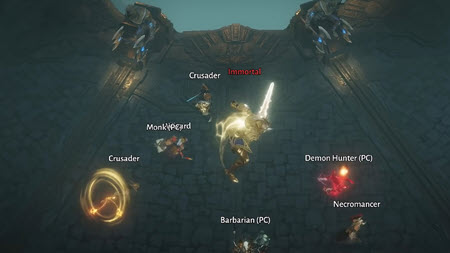
•Preparation: PvP Gear: Equip PvP-focused gear with control impairment reduction and player damage modifiers. Legendary Gems: Gems like Blessing of the Worthy for PvP are beneficial.
•Event Mechanics: Capture Points: Shadow War involves capturing three points on the map. PvPvE Elements: Expect both player and monster combat.
•Strategies: Team Composition: Similar to PvP, balance your team with tanks, DPS, and support roles. Map Control: Initial Rush: Decide whether to rush one point early or spread out for control. Middle Point: Often the key to victory; consider focusing here after securing an edge. Defensive Play: Hold points with tanks, while DPS and support deal with threats. Offensive: Use mobility to surprise enemies, especially in backline capture points. Focus on Players: Sometimes, eliminating key enemy players can disrupt their strategy more than just holding points.
•Rewards: Shadow War Currency: Used for exclusive rewards like cosmetics or PvP gear enhancements.
Paragon Points:

Using Paragon Points for Late-Game Enhancement: Paragon Levels: After reaching the level cap, you continue to gain Paragon levels, each providing a point to spend in the Paragon tree.
Paragon Boards: Vanilla Board: Core stats like damage, life, and defense. Class-Specific Boards: Focus on enhancing class-specific abilities or attributes.
How to Use Them:
1.Focus on Your Build:
2.Damage: If you're DPS-heavy, invest in nodes that increase critical hit, damage, or attack speed.
3.Survivability: For tank roles or if you're often in PvP, more health, armor, or damage reduction might be key.
4.Utility: Cooldown reduction or resource generation for classes needing frequent skill use.
5.Path Efficiency: Choose paths that give you the most benefit for each point spent. Sometimes, skipping a less beneficial node to reach a more powerful one is worth it.
6.Respec: Don't be afraid to respec if your strategy or playstyle changes. Paragon points can be reset at a cost.
Endgame Goals:
•Balance: A good balance between offense and defense ensures you're versatile across different content.
•Specialization: For specific endgame activities like Raids or PvP, consider specializing your points.
Daily and Weekly Activities in Diablo Immortal
To maximize efficiency in "Diablo Immortal" for both daily and weekly activities, here are some best practices based on community insights and guides:
|
|
Daily Activity |
What to do |
First Kill of the Day: |
Kill one enemy to claim the daily reward. This task is quick and ensures you get something for logging in. |
Free Daily Reward: |
Access the in-game Shop to claim your daily bundle, which can provide various resources like Gold, Scrap, Enchanted Dust, or Glowing Shards. |
Claim Daily Activity Reward: |
Aim to earn 120 Battle Points daily from various activities. This can stack up to three days, so even if you miss a day, you can catch up. |
Bounties: |
Complete the daily bounty cap, which is around 8 per day, for XP, Gold, and random items. This can be done efficiently in groups to speed up the process. |
Elder Rift: |
Use your free daily Crest to run an Elder Rift. If Daedessa's Blessing is active, consider running three for additional rewards. |
Iben Fahd's Sanctum: |
Visit daily to open the free chest for upgrade materials for your Vessels, enhancing your character's stats. |
Zone Events: |
Participate in scheduled Zone Events for crafting materials like Enchanted Dust and Glowing Shards. |
Horadric Bestiary: |
Decipher three pages daily for Battle Points, equipment, and more. |
Faction Activities: |
For those in Shadows or Immortals, complete faction-specific daily tasks to progress in the Cycle of Strife. |
Dungeons and Hidden Lairs: |
Run dungeons and hidden lairs for Unbound Normal Gems, which can be sold for Platinum. Aim for 3 to 5 runs daily for optimal rewards. |
|
|
Weekly Challenges |
What to do |
Helliquary Bosses: |
Kill all available Helliquary bosses at least twice per week for Scoria and other rewards. This can significantly boost your combat rating.
|
Cycle of Strife (Faction Events):
|
Prioritize faction-specific events like Defend the Vault for Immortals or Raid the Vault for Shadows. These offer substantial rewards and are crucial for faction progression. |
Warband Raids: |
Engage in Warband raids at least twice a week to gain Warband points, which can lead to better gear and social standing within your Warband. |
Elder Rifts with Crests: |
Use your weekly cap of Crests for Elder Rifts, especially when you can get Legendary Gems or other high-value drops. The weekly limit is 320 Fading Embers, so plan your runs. |
Hidden Lairs: |
Complete up to the weekly cap to maximize your gem drops, which can be sold or used for upgrades. |
Shadow Wars: |
Participate in Shadow Wars if you're in the Shadows faction for PvP rewards. These occur on specific days, so plan accordingly. |
Best Practices:
•Time Management: Set aside specific times if possible, like during a commute or a lunch break, to complete tasks. The daily routine can be done in about 1.5 to 3 hours, depending on engagement in PvP.
•Prioritization: Focus on time-sensitive tasks first (like those with daily or weekly caps), then move to activities that can be stacked or done less frequently.
•Group Play: Many tasks can be completed faster or offer better rewards when done in groups. Join or create groups for activities like bounties or dungeons.
•Resource Management: Always check the Hilts Trader for daily items to buy, especially if you're focusing on gear upgrades or crests for Elder Rifts.
Note: By following these routines and strategies, you can ensure you're not missing out on crucial rewards while keeping your gameplay efficient and engaging. |
Top 10 Tips & Tricks for Playing Diablo Immortal
Here are the top 10 tips for playing "Diablo Immortal" to enhance your gameplay experience:
1.Master Your Class: Spend time understanding your class's mechanics, skill rotations, and optimal builds. Each class has unique abilities that can make or break your performance in battles.
2.Daily and Weekly Tasks: Complete daily bounties, elder rifts, and other routine tasks for consistent progress. Weekly tasks like Helliquary bosses should not be missed for significant rewards.
3.Resource Management: Be strategic with your resources like Gold, Platinum, Crests, and Scoria. Use them wisely for upgrades, especially focusing on Legendary Gems, which can significantly boost your power.
4.Join or Form a Clan: Clans provide social interaction, help with tasks, and offer clan-specific rewards. They're also essential for tackling tougher content like Warband Raids or PvP events.
5.Prioritize Gear Upgrades: Focus on upgrading your gear as soon as possible. Salvage or dismantle lower-quality items for materials like Scrap and Enchanted Dust. Use legendary gems judiciously in your gear.
6.Engage in PvP and PvE: Participate in both PvP (like Battlegrounds, Cycle of Strife) and PvE (dungeons, world bosses) to gain different sets of rewards and experience. This also helps in balancing your character's stats for various scenarios.
7.Optimize Your Paragon Points: As you level up, distribute your Paragon Points wisely. Focus on stats that complement your build or help in areas where your class might be weak.
8.Know When to Use Gems: Unbound gems can be sold for Platinum, but higher-tier gems should be socketed into gear for boosts. Regularly check which gems are most beneficial for your current build.
9.Stay Active with Events: Diablo Immortal often has events that provide bonuses or unique rewards. Participate in these to accelerate your progress or gain items not normally available.
10.Time Management: Understand the game's time gates (like daily limits on certain activities). Plan your play sessions around these to make the most of your time, especially if you can't play daily.
11. Bonus Tip: Keep Up with Updates: Blizzard frequently updates Diablo Immortal with patches that can change game balance, introduce new content, or fix bugs. Keeping informed can help you adapt your strategies or take advantage of new opportunities.
Note: By following these tips, you'll be on your way to mastering "Diablo Immortal," enhancing your enjoyment, and improving your efficiency in the game. |
